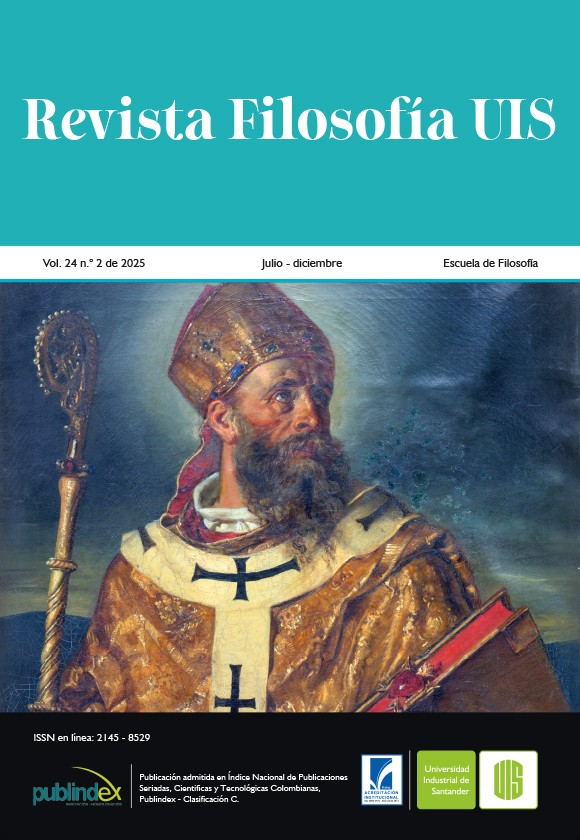Riscos associados ao uso do WhatsApp: uma reflexão a partir de Heidegger e Ortega y Gasset
Publicado 2025-03-29
Palavras-chave
- Heidegger,
- Dasein,
- Ortega y Gasset,
- WhatsApp,
- smartphones
Como Citar
Copyright (c) 2025 REVISTA FILOSOFIA UIS

Este trabalho está licenciado sob uma licença Creative Commons Attribution 4.0 International License.
Resumo
Este artigo reflete sobre os riscos ontológicos e sociais decorrentes do uso massivo do WhatsApp, analisados a partir das perspectivas filosóficas de Martin Heidegger e José Ortega y Gasset. Por meio de uma abordagem hermenêutica, são examinados conceitos-chave como o Dasein heideggeriano —entendido como ser-no-mundo— e o homem-massa orteguiano, explorando como plataformas digitais como o WhatsApp reconfiguram a existência humana. Argumenta-se que a hiperconectividade promove interações efêmeras, corrói a autenticidade das relações presenciais ao substituir a presença física por mediações digitais e fomenta um individualismo que enfraquece a solidariedade. Além disso, discute-se como a tecnologia reduz a linguagem a informação quantificável, limita a reflexão crítica diante da saturação de dados e facilita a propagação de desinformação (fake news). As conclusões destacam o paradoxo do WhatsApp: enquanto otimiza a eficiência, ameaça a essência relacional e temporal do ser humano, deslocando o cuidado (Sorge) heideggeriano e promovendo a alienação do “senhorito satisfeito” descrito por Ortega y Gasset. Enfatiza-se a necessidade de um diálogo crítico com a tecnologia, recuperando espaços de desconexão e reflexão autêntica para preservar a capacidade de questionar o sentido da existência na era digital.
Downloads
Referências
- Ávila Cañamares, I. (2021). La clase virtual. Notas para una fenomenología de la presencia. Ideas y Valores, 70(176), 157–175. https://doi.org/10.15446/ideasyvalores.v70n176.94174
- Bernal-Ruiz, C., Rosa-Alcázar, Á., & González-Calatayud, V. (2019). Development and validation of the WhatsApp Negative Impact scale (WANIS). Anales de Psicología/Annals of Psychology, 35(2), 242-250.
- Cabrera, V. C. (2024). Nudgets y Apps: El rol del smartphone en los cambios conductuales. Behanomics, 2, 167-181. https://doi.org/10.55223/bej.22
- Cortés, C & Peñarredonda, J. (2018). La política (en WhatsApp) es dinámica: Desinformación y difusión de ‘cadenas’ políticas en Colombia. Linterna Verde, Internet y sociedad. https://linternaverde.co/informe-whatsapp/.2
- Critikián, D. M., & Núñez, M. M. (2021). Redes sociales y la adicción al like de la generación z. Revista de comunicación y salud, 11, 55-76. https://doi.org/10.35669/rcys.2021.11.e281
- Datareportal (20 de enero de 2024). Digital 2024 Global Overview Rerpot. https://datareportal.com/reports/digital-2024-global-overview-report
- Fernández Vicente, A. (2019). Caminar en la era del smartphone. Revista mexicana de sociología, 81(4), 855-880. http://dx.doi.org/10.22201/iis.01882503p.2019.4
- Guerrero, M. N. (2023). Cercanía y lejanía de los cuerpos. Reflexiones fenomenológicas en torno a la espacialidad del mundo de la vida durante la pandemia. En J. P. E. Esperón (Ed.). Acontecimiento y pandemia: ensayos filosóficos para pensar la pandemia del covid-19 y reflexionar sobre sus consecuencias (pp. 84-92). Universidad Nacional de La Matanza. http://repositoriocyt.unlam.edu.ar/handle/123456789/2080
- Hambali, R. Y. A. (2023). Being in the Digital World: A Heideggerian Perspective. JAQFI: Jurnal Aqidah Dan Filsafat Islam, 8(2), 274–287. https://doi.org/10.15575/JAQFI.V8I2.30889
- Han, B. (2014). En el enjambre. (R. Gabas, Trad.). Herder Editorial.
- Han, B. (2021) No-Cosas. Quiebras del mundo de hoy. (J. Chamorro, Trad.). Taurus.
- Heidegger, M. (2009). Introducción a “¿Qué es metafísica?”. En H. Cortés y A. Leyte (Trads.). ¿Qué es metafísica? (pp. 63-93). Alianza Editorial.
- Heidegger, M. (2022). Ser y Tiempo. (J. E. Rivera, Trad.). Editorial Trotta.
- Hood, W. (2004) El problema de la técnica: El enfoque aristotélico versus el heideggeriano. En C. Mitcham y R. Mackey (Eds.). Filosofía y tecnología (pp. 479-512). Ediciones Encuentro.
- Linterna Verde (2020). El Mito del todoterreno: WhatsApp en las elecciones regionales de 2019. https://www.linternaverde.org/guias/el-mito-del-todoterreno
- Martín de Blassi, F. G. (2022). Heidegger y la hermenéutica de la serenidad (Gelassenheit). Revista de humanidades de Valparaíso, (19), 377-394. https://doi.org/10.22370/rhv2022iss19pp377-394
- Montesdeoca Suárez, A. (2024). WhatsApp como medio de comunicación entre la empresa y las personas trabajadoras: los conflictos que plantea esta herramienta. Revista Internacional y Comparada de Relaciones Laborales y Derecho del Empleo, 12(1), 318-339. https://ejcls.adapt.it/index.php/rlde_adapt/article/view/1404
- Múnera Montoya, J. C. (2022). Lo viral y el espiral de lo efímero. Revista Estudios, (44). https://doi.org/10.15517/re.v0i44.51211
- NBC News (2018, April 10). Senator Asks How Facebook Remains Free, Mark Zuckerberg Smirks: ‘We Run Ads’ [Video]. YouTube https://www.youtube.com/watch?v=n2H8wx1aBiQ
- Ortega y Gasset, J. (1964). Meditación de la técnica. En Obras completas. Tomo V: 1933-1941 (3ª ed.). (pp. 317-375). Revista de Occidente.
- Ortega y Gasset, J. (1966). La rebelión de las masas. En Obras completas. Tomo IV: 1929-1933 (6ª ed.). (pp. 113-310). Revista de Occidente.
- Resende, G., Melo, P., CS Reis, J., Vasconcelos, M., Almeida, J. M., & Benevenuto, F. (2019, June). Analyzing textual (mis) information shared in WhatsApp groups. In Proceedings of the 10th ACM conference on web science (pp. 225-234). Association for Computing Machinery
- Rocha de la Torre, A. (2013). ¿Origen o esencia? Heidegger y la concepción tradicional del lenguaje. Studia Heideggeriana, 2, 129-150. https://studiaheideggeriana.org/index.php/sth/article/view/87
- Rojas Valdés, M. (2023). Sobre los conceptos heideggerianos de existencia y estar-en-el-mundo y sus similitudes con algunos conceptos orteguianos y sartrianos. Revista Filosofía UIS, 22(2), 163-192. https://doi.org/10.18273/revfil.v22n2-2023007
- Rozgonjuk, D., Sindermann, C., Elhai, J. D., & Montag, C. (2021). Comparing Smartphone, WhatsApp, Facebook, Instagram, and Snapchat: Which Platform Elicits the Greatest Use Disorder Symptoms? Cyberpsychology, behavior and social networking, 24(2), 129–134. https://doi.org/10.1089/cyber.2020.0156
- Rubio, R. (2015). Afectividad y significaciones en la analítica del Dasein. Studia Heideggeriana, 4, 23-45. https://studiaheideggeriana.org/index.php/sth/article/view/71
- Sartre, J. P. (1966). El ser y la nada. Ensayo de ontología fenomenológica (J. Valmar, Trad.). Editorial Losada.
- Sha, P., Sariyska, R., Riedl, R., Lachmann, B., & Montag, C. (2018). Linking Internet Communication and Smartphone Use Disorder by taking a closer look at the Facebook and WhatsApp applications. Addictive behaviors reports, 9, 100148. https://doi.org/10.1016/j.abrep.2018.100148
- Sun, Y. (2024). Exploring Heidegger’s Reflections on Technology. International Journal of Social Sciences and Public Administration, 3(3), 157–161. https://doi.org/10.62051/IJSSPA.V3N3.19
- Velásquez Camelo, E. E. (2020). Virtualización y existencia: la técnica en el ámbito general de la vida. Aporía. Revista Internacional de Investigaciones Filosóficas, (20), 48-65. https://doi.org/10.7764/aporia.20.17649
- Vigo, A. G. (2015). Afectividad, comprensión y lenguaje: Heidegger y la reconstrucción aleteiológica del discurso no apofántico. Studia Heideggeriana, 4, 47-94. https://studiaheideggeriana.org/index.php/sth/article/view/72

